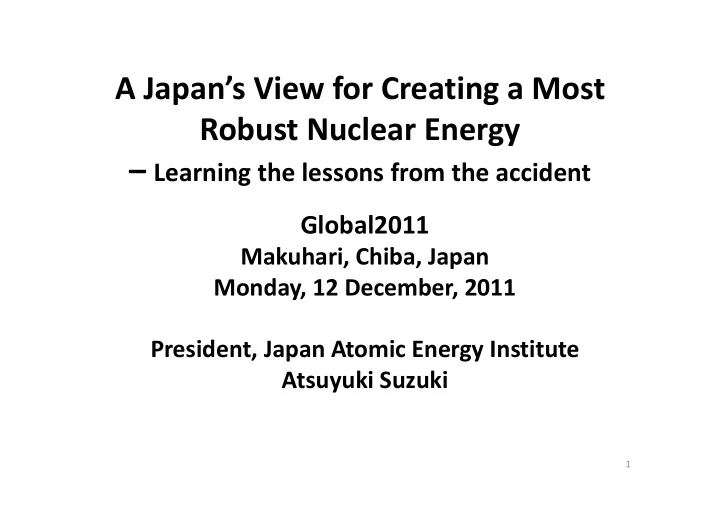

A Japan’s View for Creating a Most Robust Nuclear Energy – Learning the lessons from the accident Global2011 Makuhari, Chiba, Japan Monday, 12 December, 2011 President, Japan Atomic Energy Institute Atsuyuki Suzuki 1
Introductory Remarks • Appreciation for great helps and sympathies provided by international countries and global societies. • Repentance for global anxieties on radiological releases into environments. • Identification of the possible vulnerabilities so as to draw lessons as early as possible. • Re ‐ thinking for enhancing nuclear safety to protect external extreme events • Consideration for creation of a most robust system for nuclear energy, nationally and internationally. • The views given here are little to do with the government. 2
The Vulnerabilities Revealed 1. Preparation for immense tsunami following huge quake, 2. Prolonged loss of all AC powers, i.e., Days ‐ long station blackout 3. Operations for unanticipated accident management, 4. Hydrogen explosion at R/B, 5. Simultaneous emergency planning at multiple units, 6. Cooling spent fuel stored at pool, and 7. Learning new scientific findings. 3
How to Deal with Extreme Natural Events • PSA or Defense ‐ in ‐ depth ‐ Large uncertainties with estimate on extreme event occurrence ‐ Tremendously serious consequences, when occurred • Design ‐ based facility measures or Operational accident management ‐ Devastating impediments of vast off ‐ site social infrastructures 4
The Vital Importance of Power Supply • The good examples ‐ Kashiwazaki ‐ Kariwa NPPs, July 16 th , 2007, and Fukushima Dai ‐ ni NPPs, March 11 th , 2011 ‐ Units #5&6 in Fukushima Dai ‐ ichi, March 11 th , 2011 • Emergency power supply ‐ Non ‐ vulnerable EDGs ‐ Diversity with power supply: water ‐ cooled, air ‐ cooled, and gas ‐ turbine (for security) ‐ Independent backup power supplies for integrity ‐ preservation loads 5
Need for Learning for Reinforcing Safety • Learning new scientific findings ‐ Remarkable progresses in seismic sciences in Japan since the 1995 Hyogo ‐ ken Nambu EQ ‐ Seismically induced tsunami: The 869 Johkan EQ., M8.5, 200km dislocation, The 1960 Chile EQ., M9.5, 1,000km dislocation, and The 2004 Sumatra EQ., M9.1, 48.9m above sea ‐ level • Learning operating experiences ‐ Accident management since TMI and Chernobyl ‐ Individual Plant Examination of External Events , IPEEE ‐ Information sharing 6
Need for Industrial Collaborations • Competence of licensees ‐ Engineering, financial, and management capability ‐ Plant operation with safety at the highest priority • Information asymmetry ‐ Vendors, operators, regulators and general public ‐ The case for the 60’s/70’s Fukushima Dai ‐ ichi: General Electric (GE), Toshiba, Hitachi, and TEPCO; Regulator ‐ Stakeholders issues, to be managed based on transparency 7
Impacts on Nuclear Energy Policy • Nationally, the highest priority is given to the management of the Fukushima Daiichi and the environments. • The most influential is the serious shortage of funds available for others, governmental or non ‐ governmental. • The issue is how to create an avenue enabling us to continue the program at least costs. • Internationally, there seem three groups: little affected, much affected and in between. • The global trend that nuclear energy is growing does not change but what is important is how to follow the trend internationally. • The issue is to create international partnerships enabling each country to participate in particular in the area of back end of nuclear fuel cycle as well as nuclear safety. 8
Substantive and Procedural Safety • The substantive safety: physical protection system, based on defense ‐ in ‐ depth with reasonably conservative redundancy, i.e., in a reasonably robust manner. • The procedural safety: convincing arguments for regulations and stakeholder involvement with the highest possible level of transparency. • The interaction between the two: feedback to the substantive from the procedural so as to actualize the safety enhancement required or preferred. This is to be deemed the most robust safety. The introduction of new scientific findings into the substantive safety, for instance, would be facilitated, with the aid of social measures that are specifically prepared as a self ‐ organizational mechanism. 9
How to be Robust in the Nuclear Fuel Cycle • Spent fuel management ‐ Short ‐ term and long ‐ term storage, pool or dry ‐ Reuse at LWR or FR, with MA/L ‐ lived nuclides or not ‐ Geological repository with R&R or pilot program • Global partnerships ‐ Flexibility, to be adaptive for each nation’s situation ‐ Incentives, to be economically attractive ‐ Transparency, to give no concerns about proliferation 10
Concluding Remarks A most robust safety system could be achieved, appropriately • learning the lessons. As a safety measure, emergency power supply plays a vital role. • How robust is robust enough could be addressed with the safety • design philosophy of defense ‐ in ‐ depth. The system should be flexible enough to adapt the new findings, • whenever necessary. For that purpose, an initiative should be taken from the industry. This • is related to information asymmetry issue. How to manage the information asymmetry is crucially important for • establishing a robust safety system and the transparency might be a key element. In Japan, most crucial is how to create an avenue that enables • continuing the nuclear development program in a most robust manner. Internationally, partnerships are particularly required for a robust • nuclear energy system, pursuing the safe, secure and steadily expanded use of nuclear energy. 11
Recommend
More recommend